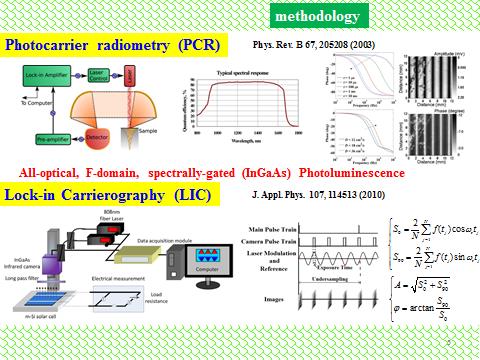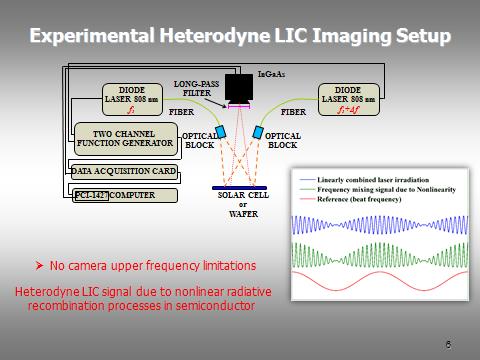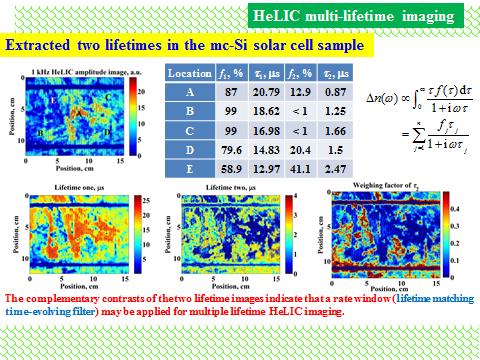Solar cell technologies are rapidly growing in Canada and elsewhere due to strong demand for alternative energy sources. Current (“conventional”) techniques for the physical characterization of solar cells and materials require sample preparation and are mostly destructive or qualitative. Non-destructive testing (NDT), non-destructive imaging (NDI) and quality assurance methodologies suitable for the optoelectronic and other semiconductor device industry are becoming increasingly important. A major CADIPT thrust has been the development of new diffusion-wave NDT/NDI techniques for the evaluation of photovoltaic (PV) solar cells. Our group has been developing dynamic non-contacting quantitative inspection methods for monitoring (opto)electronic quality in substrates and devices at any and all stages of fabrication. Specifically, the key photogenerated carrier-density-wave transport properties: recombination lifetime, surface recombination velocities and electronic diffusivity can be measured by means of photocarrier radiometry (PCR) [1]. Two novel dynamic imaging extensions of PCR, lock-in carrierography (LIC) [2] and high-frequency heterodyne LIC (HeLIC) imaging [3,4]. The theoretical basis of LIC imaging of photovoltaic solar cells has been presented by Mandelis et al. [5]: an optoelectronic diode equation was derived, linking the emitted radiative recombination photon flux (current density), the solar conversion efficiency, and the external load resistance via the closed- and/or open-circuit photovoltage. The equation was shown to be of a structure similar to the conventional photovoltaic I-V (Shockley) equation, allowing the carrierographic image to be used in a quantitative statistical camera pixel brightness distribution analysis. The statistical theory was further generalized to yield an all-optical PCR expression with incident light flux variation replacing the load resistor in varying the generated photovoltage. The theory allowed the carrierographic image to be used in a quantitative statistical camera pixel brightness distribution analysis, linking it to the measurement of solar efficiency. In studies we compared conventional HgCdTe-camera lock-in thermography (LIT) and InGaAs-camera-generated LIC images of a multi-crystalline (mc) Si solar cell, and demonstrated the superior defect spatial resolution of LIC compared to the LIT image.

The figure above compares conventional HgCdTe-camera lock-in thermography (LIT) (left) and InGaAs-camera-generated LIC (right) images of a multi-crystalline (mc) Si solar cell at 10 Hz and shows the LIC camera pixel brightness distribution (middle). The superior defect spatial resolution of LIC compared to the LIT image is readily apparent.
Photocarrier transport properties and the effects of interface defect densities in Si substrates deposited with amorphous layers and representing intermediate fabrication stages of amorphous Si solar cells, have been investigated using PCR and LIC [6,7].




In the figure above, several LIC images obtained at various frequencies were used to synthesize an image of photocarrier diffusion-wave lifetimes by fitting the frequency responses of each camera pixel to a theoretical rate equation that includes the carrier lifetime as a fitting parameter.

In the figure above dynamic heterodyne lock-in carrierography (HeLIC) images of photo-carrier density-wave multiple lifetimes, including the weights (probabilities) for their occurrence were constructed from the frequency response of the each camera pixel
Impact: PCR and its near-infrared camera imaging extensions, LIC and HeLIC, yield important insights into the optical-to-electronic energy conversion mechanisms in PV structures like mc-Si, thin-amorphous, and colloidal PbS quantum-dot solar cells which will help improve the fabrication process and their solar efficiency. This work opened the way for solar-cell optoelectronic quality control and manufacturing feedback at any and all stages of fabrication and before final metallization using mc-Si solar cells.
References II.1
[1] Mandelis A, Batista J, and Shaughnessy D, Infrared photo-carrier radiometry of semiconductors: Physical principles, quantitative depth profilometry and scanning imaging of deep sub-surface electronic defects, Phys. Rev. B 67, 205208-1-18 (May 2003).
[2] Melnikov A, Mandelis A, Tolev J, Chen P, Huq S. Infrared lock-in carrierography (Photocarrier radiometric imaging) of Si solar cells, J. Appl. Phys. 2010; 107, 114513.
[3] Melnikov A, Chen P, Zhang Y, Mandelis A. Lock-in and heterodyne carrierographic imaging characterization of industrial multicrystalline silicon solar cells, Int. J. Thermophys. 2012; 33 (10-11) 2095.
[4] Mandelis A, Melnikov A. (Inventors) “Method and apparatus for performing heterodyne lock-in imaging and quantitative non-contact measurements of electrical properties” (U.S. Patent 9,131,170, Issued September 8, 2015).
[5] Mandelis A, Zhang Y, Melnikov A. Statistical theory and applications of lock-in carrierographic image pixel brightness dependence on multi-crystalline Si solar cell efficiency and photovoltage, J. Appl. Phys. 2012; 112, 054505.
[6] Liu JY, Melnikov A, Mandelis A. Silicon solar cell electrical parameter measurements through quantitative lock-in carrierographic (photoluminescence) and thermographic imaging, Phys. Stat. Sol. A 2013; 210 (10), 2135.
[7] Liu JY, Melnikov A, Mandelis A. Contactless measurement of electrical parameters and estimation of current-voltage characteristics of Si solar cells using the illumination intensity dependence of lock-in carrierography (photoluminescence) images, J. Appl. Phys. 2013; 114, 104509.
